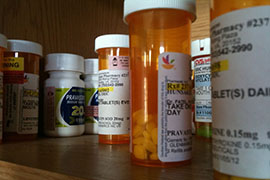- Slug: BC-CNS-Opioid Locals,540
- Photo available (thumbnail, caption below)
By JESSICA SUERTH
Cronkite News
WASHINGTON – Arizona communities need to do more to combat and treat drug addictions or face potentially devastating long-term consequences, Coconino County’s chief health officer said during a national conference call this week.
Dr. Marie Peoples said cities and towns in Arizona are “behind the eight ball” in terms of providing treatment for opioid addicts. Among possible solutions, she said, are implementing a prescription monitoring system and tracking data from medical examiners and emergency rooms.
If local officials do not fix the problem, Peoples said during a call on what local communities can do to fight the drug epidemic, they could face long-term consequences, including rising child care and emergency room costs.
“These are real-world problems facing us today,” Peoples said during the International City/County Management Association call. “It’ll be even more difficult to deal with in the upcoming years.”
Peoples said Arizona “fortunately hasn’t faced an intense epidemic,” compared to states with high overdose death rates like New Mexico and Ohio, but is not exempt in terms of an opioid addiction crisis.
The latest figures from the Centers for Disease Control and Prevention reported that 1,211 people in Arizona died from opioid overdoses in 2014. Opioids include illegal drugs like heroin as well as prescription drugs, such as Oxycontin and Vicodin.
An additional 1,052 people in the state required emergency room treatment for drug overdoses that year, the CDC found.
“The issue is on our radar,” Peoples said. “We look at arrest data, but we can’t arrest our way out of this problem.”
The Arizona Department of Health Services found an increase in the number of deaths in 2014 for both prescription and heroin overdoses. Heroin overdoses accounted for 605 deaths in 2014, up from 521 in 2013. Prescription drug overdoses claimed, on average, one person per day in 2014, the state data showed.
Dr. Daniel Derksen, director of the University of Arizona’s Center for Rural Health, said a viable option for combating opioid overdoses is enacting local prescription drug monitoring programs. They let doctors and pharmacies check for potential abuse by tracking how often a patient is being prescribed highly addictive medication.
“One of the areas we can work on is educating health providers and pharmacies on the appropriate use of controlled substances,” he said. “States with these programs have done well (in terms of combating opioid addiction).”
Marty Harding, director of training and consultation at the Hazelden Betty Ford Foundation, said although community intervention is essential to fighting the drug epidemic, regional officials need to work together to protect their cities from being exposed to an influx of opioids.
“This issue does not stop at your border,” she said. “State leaders need to have a regional conversation and have an effective strategy for prevention with treatment and law enforcement.”
Derksen acknowledged that Arizona has made progress in addressing the problem with opioid addiction in the state, but said local communities need to start addressing the issue independent of state and national governments.
“It’s a fairly accurate description to call this an epidemic,” he said. “As communities understand better how devastating this problem really is, they can approach it from a public health perspective, where they are dealing with different tools to improve on health outcomes.”
^__=
Web links:
_ Arizona overdoses 2014: http://azdhs.gov/documents/prevention/womens-childrens-health/reports-fact-sheets/injury-prevention/rxdrug-od-fact-sheet-2014.pdf
_ CDC data: http://www.cdc.gov/drugoverdose/data/statedeaths.html
_ Center for Rural Health: http://crh.arizona.edu/
^__=
The Centers for Disease Control and Prevention reported that 1,211 people in Arizona died in 2014 from overdoses of opioids, both prescription and illicit drugs. (Photo by Eric Hunsaker/Creative Commons)
